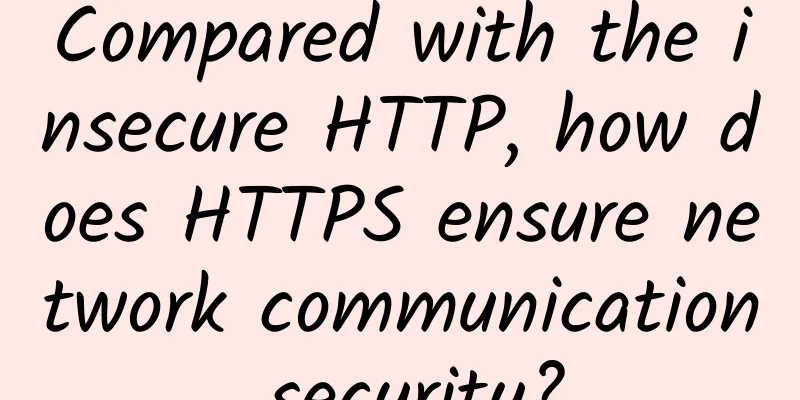Compared with the insecure HTTP, how does HTTPS ensure network communication security?

|
HTTP is an excellent communication protocol, but everything has two sides. The protocol also has shortcomings, which are roughly as follows:
1. HTTP does not have encryption function The HTTP protocol itself does not have encryption function, so it is impossible to encrypt the content of requests and responses. HTTP messages are in plain text, and data packets can be easily stolen when transmitted between networks, such as using packet capture tools (Wireshark). After capturing the data packets, they are analyzed. Since the messages are transmitted in plain text, if the content is about important privacy such as personal information, it may be obtained by others and used, causing losses. 2. Encrypt the content Encrypting content is a good way to protect information. HTTP does not have an encryption mechanism, so a third party is needed to help implement encryption. There are many ways to encrypt content, such as:
It is mainly divided into two categories, symmetric encryption and asymmetric encryption (we will not discuss encryption in depth here, and friends who are interested can refer to relevant information).
3. The shortcomings of only encrypting the content
Therefore, only encrypting the content is not perfect. A more comprehensive security solution is needed to ensure not only the security of the content but also the security of communications and other aspects - HTTPS. 3. What are SSL and TSL? Before discussing HTTPS, we need to understand the SSL and TLS protocols.
SSL technology was initially developed by Netscape, which developed versions before SSL3.0 and then transferred the leadership to IETF. IETF developed the TSL protocol based on SSL. The current mainstream versions are SSL3.0 and TLS1.0. 4. Basic concepts of HTTPS HTTPS is not a new protocol, it is to replace the HTTP protocol communication interface part with SSL and TSL protocols. As shown in the following figure: Analysis: HTTP and TCP communicate directly at first, but now HTTP communicates with SSL first, and then SSL communicates with TCP. It can be understood that HTTP becomes HTTPS by adding an extra layer of SSL protocol. Below, HTTPS is expressed through a formula: HTTP + encryption + authentication + integrity protection = HTTPS 5. How does HTTPS communicate? Overview: The HTTPS communication process combines symmetric encryption and asymmetric encryption. When the HTTPS server establishes SSL communication, it will first send its public key to the client. After the client obtains the public key, it negotiates with the server through asymmetric encryption for the symmetric encryption key of the data transmission channel. Once the two parties have negotiated a session key, subsequent data communications will always use the symmetric encryption algorithm based on the session key. Specific process:
Is using HTTPS perfect?
HTTPS is slower than HTTP because it requires SSL communication in addition to TCP connection and HTTP request response. Secondly, the client and server need to perform encryption and decryption processing. When the number of visits is large, the load will increase compared to HTTP. In addition, HTTPS communication requires the purchase of a certificate, which may not be cost-effective for some services or small websites. 6. In what scenarios is HTTPS more suitable? In summary, HTTPS is suitable for encrypted communication in services that require high security, such as transaction payment, including some services that may contain personal sensitive information. For non-sensitive information, HTTP communication is used.
VII. Conclusion HTTP is an excellent protocol, but its security is relatively poor due to reasons such as its lack of support for encryption. There are many ways to improve security, such as using encryption algorithms to encrypt content. The HTTPS protocol provides a more complete solution. HTTPS is not a new protocol, but a combination of HTTP and SSL/TSL to achieve communication security. However, HTTPS also has its shortcomings, so it must be used reasonably in combination with specific scenarios to give full play to the powerful role of HTTPS. |
<<: Huawei releases next-generation CloudLink video conferencing solution
>>: How 5G will revolutionize healthcare
Recommend
Illustrated explanation of the past and present of four IO models
Recently, I have come to believe that when explai...
iPhone 12 will be released next week, but 5G in the US won't work at all
Apple announced in the early morning of October 7...
How will 6G develop in the future?
In the past two years, with the gradual populariz...
Testing infrastructure is like a butcher's knife, WOT Ru Bingsheng tells you how to avoid "falling into the trap"
【51CTO.com original article】Seven years of hard w...
ICMP protocol full analysis
1. Introduction to ICMP The full name of ICMP is ...
How to deploy multiple computer rooms? How to synchronize data?
Author: Guo Guanhua, unit: China Mobile Smart Hom...
AlphaVPS: Bulgaria dedicated servers from €34.99/month, VPS hosting from €15/year
AlphaVPS is a leading IaaS provider in Europe (DA...
How to estimate the power configuration of 5G base stations?
5G base station construction, supporting faciliti...
In the 5G era, how to innovate network construction models?
The full opening of the 5G commercial era and the...
Analysis on the Evolution of Home Wi-Fi Transmission Network Technology
Author: Tang Xiangming, Unit: China Mobile Smart ...
6G brings an innovative revolution, but also hides many crises and challenges
Although 6G will not be implemented until 2030, t...
VPSMS: 53 yuan/month KVM-512MB/15G SSD/1TB/Los Angeles CN2 GIA
VPSMS is currently holding a two-year anniversary...
DiyVM: Hong Kong CN2, US CN2, Japan Osaka, 2G memory package starting from 50 yuan/month
DiyVM was founded in 2009 and is a Chinese hostin...
spinservers: US high bandwidth servers starting from $89/month, San Jose/Dallas data centers, 10Gbps bandwidth
spinservers recently released a new promotion pla...
What is a Fibre Channel Transceiver?
Fibre Channel is a network storage switching tech...







![[Black Friday] SoftShellWeb: $8.99/month-1GB/20GB/100GB@1Gbps/Taiwan VPS](/upload/images/67cabce4e3555.webp)

